Introduction
Heartland Concept
At the onset of the 20th Century, while working on the geopolitical situation and geo-economic setup of Europe and Asia, Halford Mackinder conceptualized the pivot area (Ismailov and Papava 84). This later improved into the fully fledged concept of Pivot Area (or the heartland Concept).
Mackinder drew opinion from the global historical activities on the premises that the world was segmented into pockets of areas that individually had distinctive functions (Ismailov and Papava 85). For instance, the initial modernization of Europe was an aftermath of foreign forces. He postulated that the progress and expansion within Europe resulted from an influential pressure at the Asia core.
Thus, the Heartland had the influence of a pivot on nearly every geopolitical transformation that had historical perspective within the World Island (Ismailov and Papava 85). In this case, the Concept of Heartland applied within the geographic context of Asia and Europe (Ismailov and Papava 85). Heartland theory develops the geostrategic nexus between spatial control and supreme governance (Scott and Alcenat 4).
In the Canadian perspective, a progressive economic situation thrives where economic activities involve market exchange between the industrial heartland and natural resource rich hinterland (Billen, Garnier and Barles 249). This paradigm has predominated geographical perspectives in Canada.
Heartland-hinterland approach is synonymous or relative to the metropolitanism in which the metropolises (or the heartland) are the epicenters for government, industry, commerce and trade as well as political power but allow interdependent linkages with the peripherals (or the hinterland). Heartlands are suitable areas with physical qualities that relatively support industrial activities at all levels; superiorly than the surrounding environs (hinterlands) (Horne 48).
Figure 1: The Canada’s Heartlands

Adopted from Filion (31)
Hinterland Concept
Basically, hinterland refers to the rear region from which raw resources driving heartland originate from. The hinterland’s (periphery) of Canada comprise of the western, northern as well as the Atlantic Provinces (Akwawua 6).
The hinterland includes the Maritime Provinces that were the symbol of early industrialization in Canada. Urbanized areas in the hinterland include the Calgary, Vancouver, Winnipeg and Edmonton (Filion 5). The criticism on the conceptual framework of the heartland-hinterland approach focus on the main relationship subsets such as labor, direction of resources flow, capital and commodities supplies to the market from either the hinterland or heartland (Matteo 3).
The Concept of Heartland & Hinterland Relationship in Canada
Canada’s Core-Periphery Concept
According to Akwawua (6) this concept explains the unbalanced dependence existing between regions (mainly, the urban and non-urban locations) resulting in a core (otherwise known as the heartland) being outstanding over the periphery (referred to as the hinterland). The concept of heartland-hinterland relationship explain the unequal development difference between a core area experiencing accelerated industrial growth and the rest of the country characterized by dispersed and cyclical development (Rice 1).
The level of socioeconomic advancement, manpower capacity as well as resource endowment makes the heartland’s outstanding (Akwawua 6). There exists some level of dependence relationship between the hinterland on the heartland in terms of politics, economics as well as cultural bottom-lines. The historical advent of the heartland and hinterland in Canada’s economic capacity emerged with the core located at Quebec and Windsor corridor, while Montreal and Toronto became distinguishably outstanding.
The MacCann and Simmons (2000) Theory
According to Wyly (14), MacCann and Smith came up with a Hinterland-Heartland model that integrates principles from the staples theory, economic base theory as well as the innovation diffusion theory. The staples theory was developed between 1894 and 1952 by Harold Innes and relates the change and growth in a regional economy as influenced spatiotemporally by the discovery and exploitation of a resource (Wyly 11).
The economic base theory argues that a prosperous and professional sector gears diversification and urban growth. The innovation diffusion theory argues that competition and information sustain a situation where relatively small urban centers have unstable growth and decline rates compared to bigger cities (Wyly 8).
Based on the MacCann and Simmons model, it’s evident that Canada has an industrial heartland (the provinces of Ontario and Quebec), while the rest represents the hinterland (that supplies raw resource inputs to the heartland). Canada’s hinterlands are primarily under agriculture, minerals, fishing and forests (Akwawua 6).
McCann and Simmons gave three definitions characterizing the Canada as whole in terms of hinterland-heartland perspectives (Wyly 14). First, they identified a dominant core area that had industrial tendencies and had attracted a huge settled population. This was a corridor linking Quebec City and Windsor (Wyly 14).
Second were the resource latent areas (ecumene) that is, the Maritimes, Prairies (much of Western Canada) and the Canadian Shield. Akwawua (6) explains that New Brunswick, Newfoundland, Nova Scotia and the Prince Edward Island constitute the Maritimes. The Alberta, Manitoba and Saskatchewan form the Prairies. The third characteristic was the hardly populated areas that stretch to the country’s far north (Wyly 14).
Figure 2: The Canadian Hinterland-Heartland Model as Depicted by McCann and Simmons (2000)
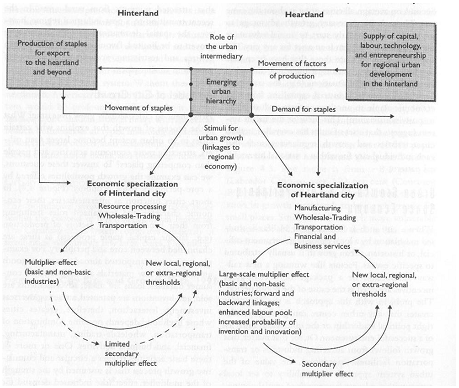
Adopted from Wyly (14)
Heartland & Hinterland Relationship in the Demographic Pattern (Population Distribution) Context in Canada
Worldwide, Canada is ranked 36th with reference to population size. Canada’s area bordering the USA (covering 150 km stretch) hosts about 70 percent of which 20 percent does not reside in cities (Wyly 17). During the confederation of Canada, the populace was younger but due to small families and extended life spans, this has led to a rise in the number of those aged 65 and above.
Those aged 65 years and above accounted for 5 percent of the populace before the 21st Century; however, the figure has exponentially risen to 25 percent. The rise in the proportion of the aging population will translate to increase in demand for services associated with this age group. In the Canadian setting, those in the working age are within the age bracket of 18 to 64 years.
Vancouver, Toronto and Montreal metropolitans host a third of the population residing in Canada. With the addition of Quebec City, Ottawa-Gatineau, Edmonton, Winnipeg and Calgary the number of the populace rises to half of national count. Winnipeg, Calgary and Edmonton are in the hinterland regions but the others lie within the heartland regions. In the Canadian setting, the moderate persons reside in large metropolitan environments.
The general population density of Canada is less-than one person per square kilometer. Ontario has the largest population size such that out of five Canadians, three are from there. Over 30 million people reside in Ontario. Quebec Province is the largest in terms of land mass. Ontario is the home of the English speakers; while Quebec hosts French speakers.
The Staple Theory & History of Migration
The Staple Theory developed by Harold Innis, puts into perspective the settlement pattern prior to the industrial advent in Canada and at the onset of the 20th Century and during the early European occupation era (Filion 4). The foreign demand for commodities facilitated the development of the transportation systems, population explosion as well as size and patterns of settlement (Markey Pierce and Vodden 429). External demand for commodities came from France and Great Britain.
The kind of product demanded influenced the type of transport systems and density patterns of settlement. Innis builds a case of the lumber having contrasting impact on the St. Lawrence Basin as a staple product, from that of fur (Filion 4). Lumber greatly influenced immigration and settlement compared to fur because of the large return over heavy return cargo. Export agriculture required more manual labor leading to rural migration; moreover, lumber and fur as well as mineral exploitation were not labor intensive.
The rural setting was characterized by centers with a handful population preoccupied with exploitation and harvesting of resources, alongside diminished market and service centers. The urban setting had a few huge cities that participated as the hubs for transshipment; the administrative centers for staples exploitation and shipment businesses (Filion 5).
Figure 3: Population Change (in %) from 1971 to 2006
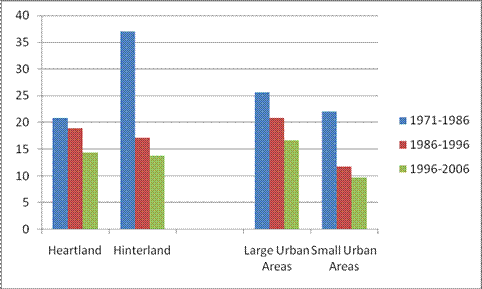
Adopted from Filion (32)
The rise in fuel prices and the growth of demand for more locally produced resources led to demographic growth as well as rise in employment and income for the hinterland region compared to the heartland region in the period starting from 1971 to 1986. Moreover, dismal population and economic growth in the Montreal could be another additional explanation. In between 1986 and 2006, population expansion rates led to demographic convergence between the heartland and hinterland.
Figure 4: Density Pattern at the Hinterland and Heartland Regions in Canada
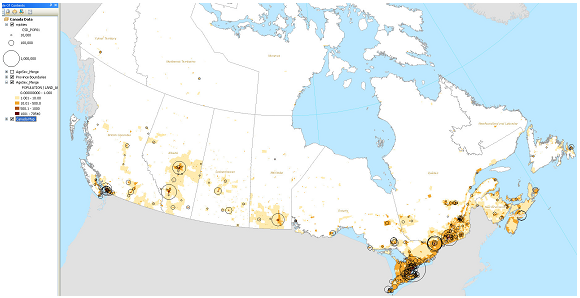
Adopted from Wyly (17)
For twenty years since 1951, the population growth at the heartlands bypassed that of the nation as a whole, with the population occupancy accounting for 55 percent of the country (Filion 5). Thereafter, population growth became localized in certain pockets of the heartland. Population growth in these pockets was stimulated by expanding sectors of the economy. One of these kinds of sectors was the car industry (Filion 5).
The migration of the Anglophones from the Quebec Province in the heartlands due to the increased presence of the French presented a drawback to the increasing population. Nevertheless, this worked in favor of the sunset labor intensive sectors like the apparel and textiles (Filion 5).
The Net Migration Pattern
The pattern of migration in relation to the hinterland and heartland was dictated by the socioeconomic opportunities at the place of destination and the flow of migrants was from the hinterlands to the heartlands (Akwawua 6).
Credible scholarly sources indicate that historical patterns in the internal migration within Canada was a positive net migration destined to the heartlands of Ontario and Quebec Provinces between the years 1901 and 1961 (Akwawua 7). Nevertheless, there were declines experienced during the periods of 1911-1921and 1941-1951 in the Province of Quebec.
Figure 5: Net Migration Patterns Between 1961 and 1991
Adopted from Akwawua (11)
It is evident from the data that Ontario Province is the dominant heartland attraction for migrants compared to Quebec Province. The British Columbia Province has always had a positive net migration, though it is in the hinterland.
Figure 6: Internal Migration Patterns for Heartlands and Hinterlands (Between 1961 and 1991)
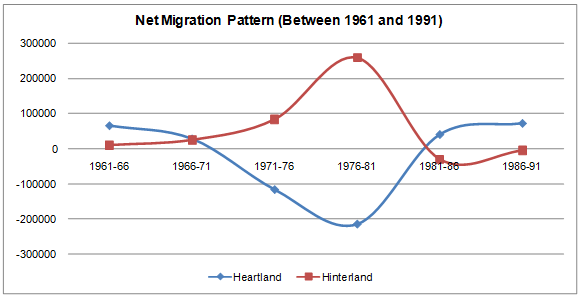
Data Sourced from Akwawua (11)
The above chart shows that Canada experienced an anti-climax for the heartland in 1976-1981. During the same period, the hinterland had a climax. Nevertheless, the net migration thereafter has had a positive cline for the heartland over the hinterland.
Figure 7: Age Distribution Across The Population Types
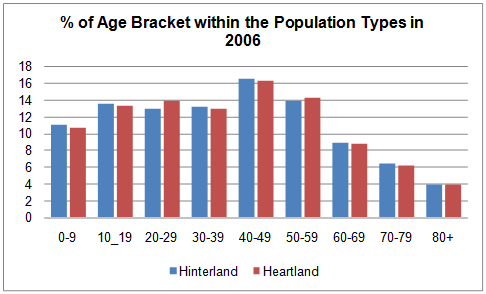
Data adopted from Filion (28)
The hinterland region displays a striking pattern of age distribution. Filion (12) provides three possible explanations for these trends. One perspective considers the poor economic performance in the urban areas of the hinterlands that result from the migration of the working class who are in the child rearing age. Areas in the hinterlands that display this trait are the Thunder Bay, Chicoutimi-Jonquière, Nanaimo and Sault Ste Marie.
The second perspective considers the general complexities within population dynamics that affect urban places within the heartlands that result from de-industrialization. Examples of such places are the Kingston, Sarnia, Trois-Rivières and Peterborough.
The last perspective considers the intricacies that arise due to retirement communities, such as in Kamloops and Kelowna. Filion (12) observes that migration and immigration are the probable factors that will lead to a growth in demographic within the urban areas, countrywide. The direction of flow will be determined by the attraction opportunities.
Heartland & Hinterland Relationship- Economic Activities
Nature of Canadian Economy
Prior to the 20th Century, agriculture dominated the Canadian economy. However, the economy ushered industrialization leading to the emergence of the heartland regions. The industrial heartland engages primarily on manufacturing activities whose raw resource supply is the hinterlands.
Fiscal Aspect
Attending to fiscal issues at inter-regional level (between the hinterlands and heartlands) through the policy approach has had serious shortcomings. Moreover, the policy influence on federal tariff has sparked debate on economic interdependence between central Canada, western and the Atlantic Provinces (Matteo 3).
The inter-regional implication of the National Policy on Tariffs was a tilt of the economic balance against the hinterland. This is an indicator of state policy inefficiency on equity and re-distribution of incentives. Inferences from analysis of the National Policy on Tariffs showed that tariffs maintaining high costs of industrial imports favored industrial production growth in Central Canada at the expense of the disparities in the regional incomes between the central Canada and the rest of Canada (Matteo 4).
State revenue collection systems present a complex scenario where the mainstream policy triggers uneven welfare and development landscape. The policies of the state are politically manipulated and rarely prioritize market forces and trends; yet tax regimes and expenditures by the state reflect the control over economic resources (Ray, Lamarche and Biffignandi 3). The comparison between economic activities and gross domestic product, showed a greater margin in the current centuries than former.
Most political decisions that impact on the hinterland progress are developed at administrative centers that are physically and culturally remote to the hinterlands; thus, is possible to have regional alienation as a byproduct (Matteo 4).
Figure 8: Manpower Categories Across Population Types
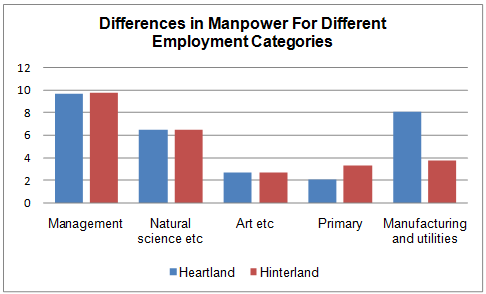
Data adopted from Filion (27)
The intensity of professions in management, natural and applied sciences in both hinterlands and heartlands shows minimal disparities. However, in the primary and manufacturing categories, there are distinctive differences. Heartlands region leads in the manufacturing category while hinterland in the primaries category.
Moreover, primaries offer fewer employment opportunities while manufacturing category experience decline in employment opportunities. Filion (12) observes that large metropolitan regions have employment rates in the manufacturing category that surpass the national average. However, the observation for the primaries is a vice versa.
Within the hinterland regions, the three largest urban areas (all within the Western Canada) have employment within the primary category above the national average (Filion 12). However, the observations for the manufacturing present an opposite scenario.
Figure 9: Percentage Change in Household Income Across Population Types
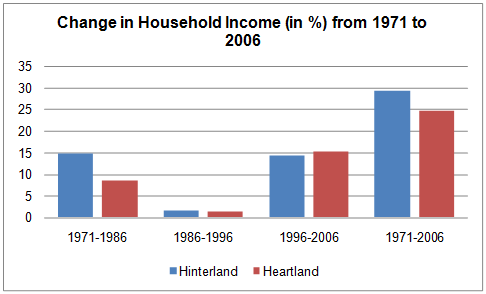
Data adopted from Filion (22)
Figure 10: Aggregate Household Incomes Across Population Types
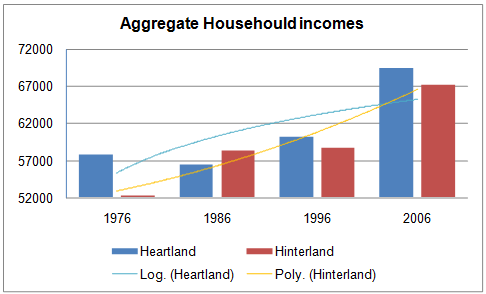
Data adopted from Filion (22)
Income levels declined until the period between 1986 and 1996, after which it experienced an upward growth. The trend witnessed resembled that of the population pattern in similar periods. The instability in the disparities between the hinterland and heartlands is explained by two factors.
One, the mixed impact of urbanization across the two region types, causing accelerated growth, stagnation or a decline (Filion 11). Differences in performance among the industrial sectors within the heartland region could lead to diversity in growth styles (Filion 11). Among the possible sources of the intra differences are the sunset and sunrise industries.
In the case of hinterland region, the intra differences in growth resulted from lack of unequal demand cycle for their raw resources. In addition, the lack of synchrony in peak periods for crude oil as well as lumber. Expansion of urban locations in both heartlands and hinterlands can lead to their convergence.
Industrial Aspect
Akwawua (6) borrows from the Canada’s Main Street that the industrial heartland (or core) in Canada stretches from Windsor via the Toronto area and then northeast ending up in Montreal and Quebec but along the St. Lawrence River. Filion (5) explains that the heartland is founded on tariffs and thrives on branch plants.
Data evidence showed that the domestic export traffic within the annual period ending 1997 comprised of more than two-thirds from Quebec and Ontario heartlands (Akwawua 7). Half of the overall export volume, registered in 1997, originated from Ontario (Akwawua 7).
Figure 11: The Heartlands (core) of Ontario and Quebec Provinces, Canada
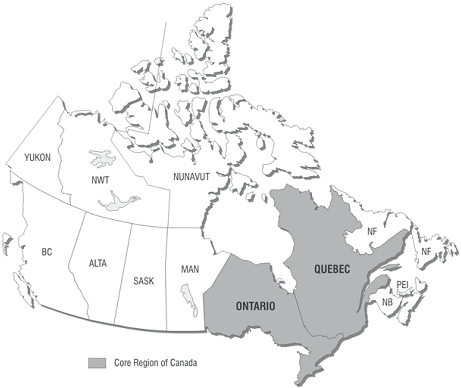
Source Akwawua (7)
Around 1994, there was a significant industrial realignment worldwide after the establishment of the Free Trade Area between the USA, Canada and Mexico (Wolfe and Gertler 2). The heartlands of Canada benefited through the exponential development of knowledge intensive industries.
Cases in point include the rapid emergence of information technology in Toronto, Waterloo and Ottawa; aerospace engineering in Montreal as well as pharmaceuticals in Toronto and Montreal (Filion 5). There is a possibility for the return into the staples-dominated economy. The developing countries (such as India and China) are presenting stiff competition in the manufacturing realms.
This will give the heartland regions in Canada difficult times, though the Canadian currency is still robust. Nevertheless, the hinterland regions will stand to benefit from the global rise in demand for their exports (Filion 7). The economic balance will incline towards the hinterlands. Considering the stunted employment opportunities in the primaries vis-a-vis manufacturing, the domestic impact of this, is unpredictable.
Conclusion
Halford Mackinder presented the initial works that led to the development of the concept of the heartlands. His scholarly works focused on the Eurasia. MacCann and Simmons (2000) furthered the concept of heartland into the heartland-hinterland relationship that modeled the economic differences in the regions of Canada.
Nevertheless, Filion (15) observes that the heartland-hinterland concept does not effectively describe the unbalanced development within the Canadian regional settings. Moreover, since 1971 the strength of growth within the heartlands vis-a-vis the hinterlands has over time weakened. The strengthening of hinterlands may revive the possibilities of national development returning to the Staple model (Filion 15).
The revival of hinterlands may gain an added advantage because of the global growth in the demand for resources. Filion (15) has the view that urbanization and urban systems in Canada may not stand to gain a lot from the hinterland development growth compared to the impact of the heartlands.
The job creation potential within the natural resource exploitation as well as the seasonal boom and/or asynchronous demand for the commodities deny the hinterland the full potential to match with the impact created by the manufacturing and service sectors present in the heartlands.
Wyly (12) warns of the vulnerability of areas that pre-occupy in the supply within the staple market. Amassing a competitive share of the natural resource aligns within the perfect competition models envisaged within the neoclassical economic theory. Nevertheless, products from the manufacturing sector may not necessarily follow the same sensitive path.
Switch in technologies as well as an adjustment in efficiency causes the ultimate lowering of the terms of trade for staples. Dependency on the foreign export for staples leads to the strong attraction of multinational firms in the domestic sector.
The transitional dynamics taking place within the policy formulation, migration and immigration as well as the economic activities may widen the hinterland-hinterland disparities, ending up with a handful of huge urban places that have high growth explosions alongside numerous smaller centers that have yet to realize their full potential for growth.
Hinterlands are the home for the numerous smaller urban places, while the heartlands host the larger ones. The services sector’s emergence and fast growth within the metropolitans compared hinterlands contributes immensely to the widening of disparities between the two regional types.
Influx in internal migration patterns within the services sector to metropolises where opportunities create a manpower vacuum at the expense of the hinterlands. Unless interventionist strategies that will level up and stabilize opportunities across the regions, inter-sector growth disparities that have regional strongholds may deny chance to the convergence between the heartlands and the hinterlands.
Already the National Policy on Tariffs has had a biased impact on the regional economy, in favor of the heartlands. This presents a lesson that implementations of national magnitude should be in touch with the diverse Canadian economy, social, political, environmental as well as cultural fabric or else it would have adverse ramifications. For sectors that have been affected, intervention strategies include redistribution policies that would lead to diminishing of polarization.
Works Cited
Akwawua, Siaw. Changing patterns of core-periphery migration in Canada, 1961 – 1991. Web.
Billen, Gilles, Josette Garnier and Sabine Barles. “History of the urban environmental imprint: introduction to a multidisciplinary approach to the long-term relationships between Western cities and their hinterland.” Reg Environ Change. 12 (2012):249–253. Springer. Web.
Filion, Pierre, 2010, Growth and Decline in the Canadian Urban System: The Impact of Emerging Economic, Policy and Demographic Trends. Web.
Horne, William. Provincial dominance: the unique case of Winnipeg. Web.
Ismailov, Eldar and Vladimer Papava. The Heartland Theory and the Present-Day Geopolitical Structure of Central Eurasia. Web.
Markey, Sean, John Pierce and Kelly Vodden. “Resources, People and the Environment: A Regional Analysis of the Evolution of Resource Policy in Canada.” Canadian Journal of Regional Science, 3 (2000): 427-454. CJRS. Web.
Matteo, Livo. Fiscal Imbalance and Economic Development in Canadian History: Evidence from the Economic History of Ontario. Web.
Ray, Michael, Rodolphe Lamarche and Silvia Biffignandi, 2011, The Geography of Employment Growth in Western Canada: A Regional Typology based on Multifactor Partitioning. Web.
Rice, Murray. Functional Dynamics and a Peripheral Quaternary Place: The Case of Calgary. Web.
Scott, Margaret, and W. Alcenat, 2008, Revisiting the Pivot: The Influence of Heartland Theory in Great Power Politics. Web.
Wolfe, David, and M. Gertler, 1999, Globalization and Economic Restructuring in Ontario: From Industrial Heartland to Learning Region? Web.
Wyly, Elvin, 2012, Theories of Urban System Development. Web.